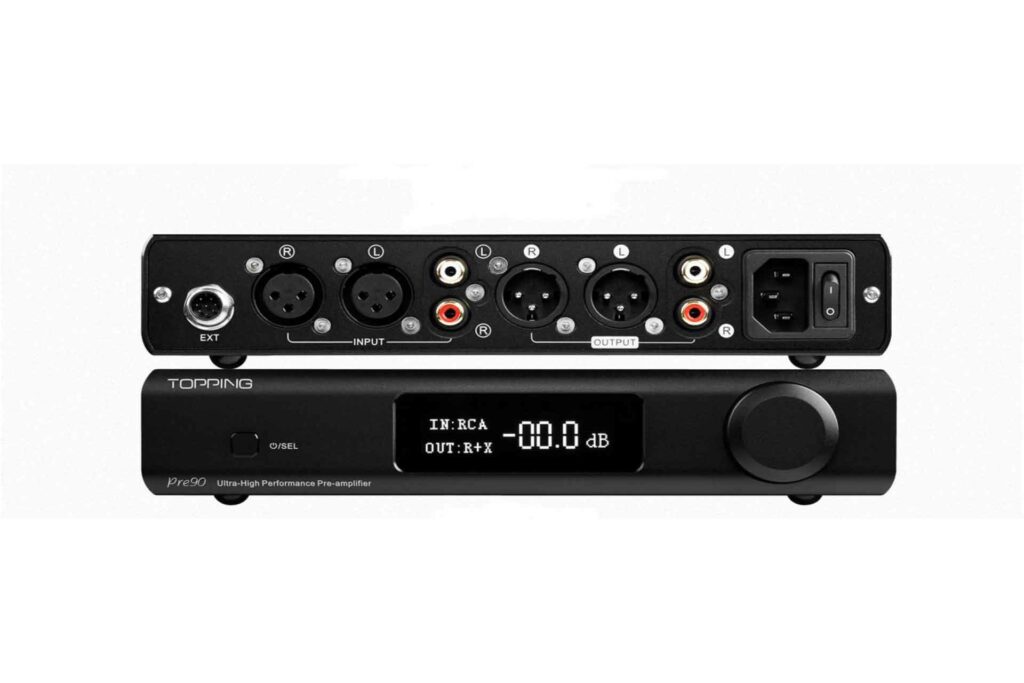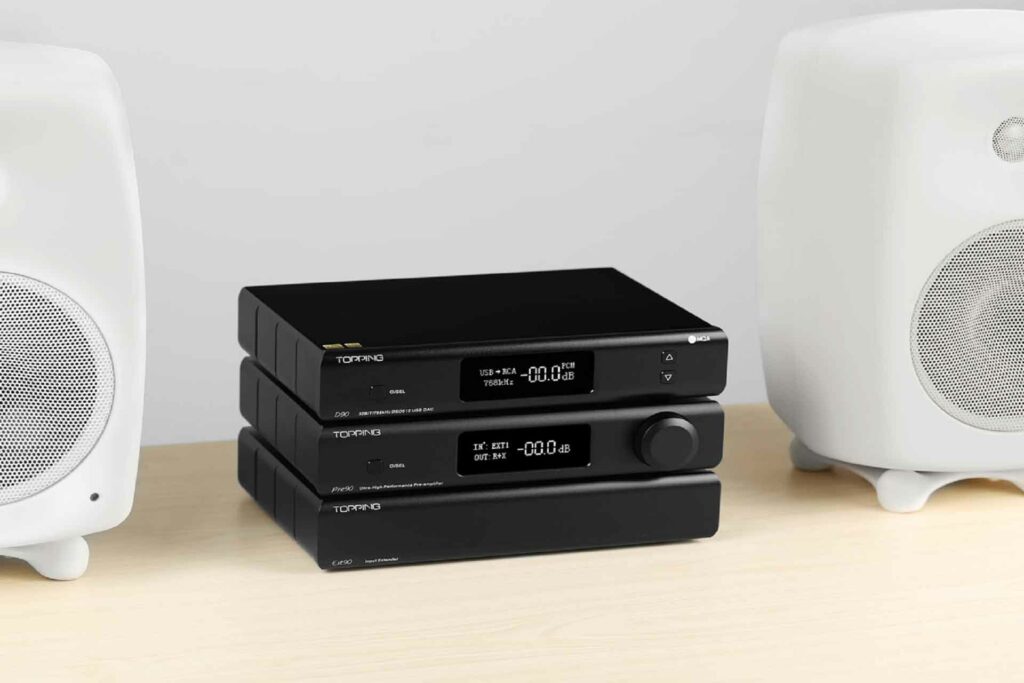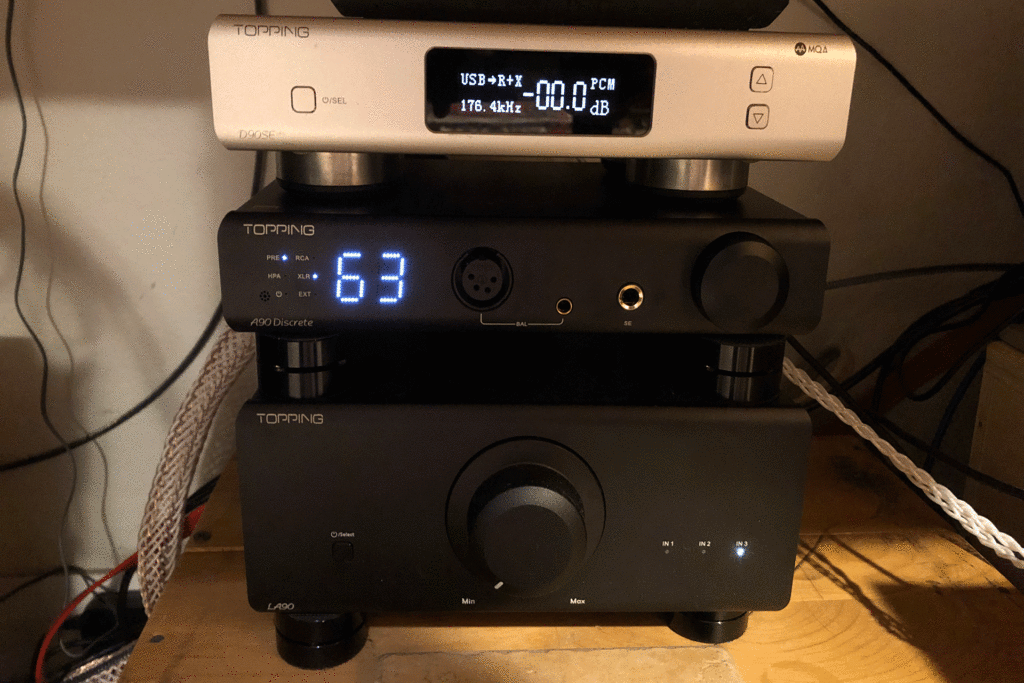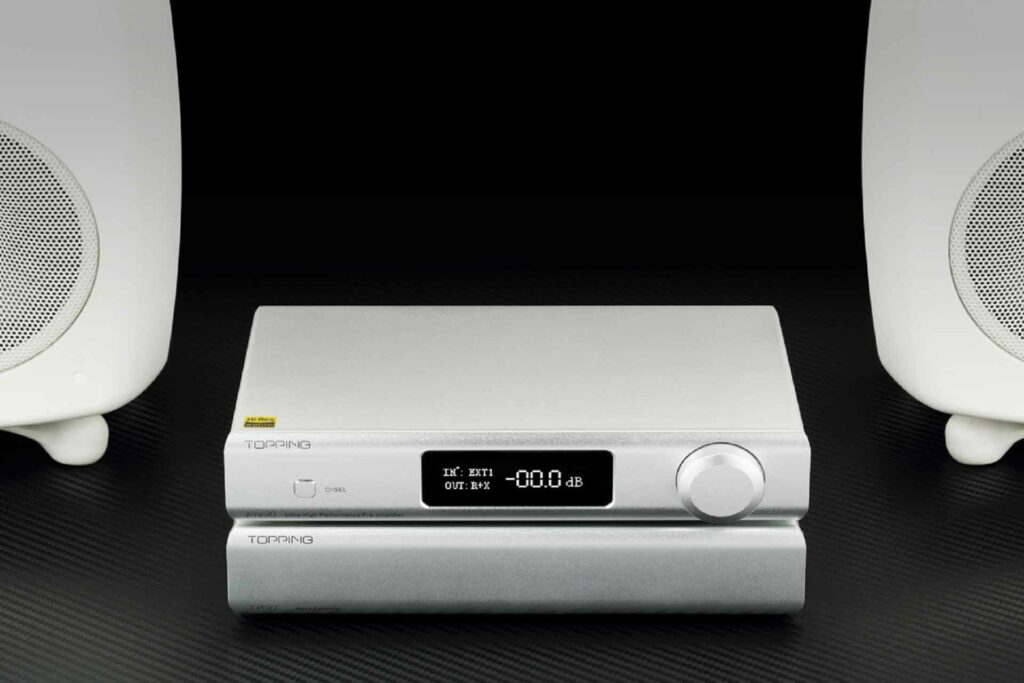Every audio system has a preamplifier somewhere in the signal chain. In an all-digital system, the digital audio converter often includes a volume control, which is in essence a single-source preamplifier. In analog systems, the preamplifier is usually a freestanding component that allows for source switching and adjusting volume levels. While these are simple tasks, they are critically important if you expect to get optimal performance out of your audio system.
What Makes the Topping Pre90 Special?
Topping has been producing this analog preamplifier since 2016. The internal circuitry utilizes true balanced differential circuit topology, which offers superior signal-to-noise to a single-ended circuit. With provisions for both single-ended and XLR balanced inputs and outputs and the capability to add an extension chassis (the Ext90) to get additional input options, the Topping Pre90 (buy at Amazon at $599) can be incorporated successfully into a wide variety of audio systems. It also delivers state-of-the-art signal-to-noise at 124 dB, as well as distortion specifications that rival preamplifiers costing 20 times more.

Why Should You Care About the Topping Pre90?
- If you want to use both balanced and unbalanced analog sources and need to send those signals to a balanced and/or unbalanced amplifier, powered speaker, or subwoofer, the Topping PRE90 has the necessary inputs and outputs to do that.
- The Topping Pre90 has a monochrome front-panel display that features volume level adjustments in 0.5-dB steps, which allows for small volume changes. It also displays your current input and output status.
- In addition to making volume adjustments via the included remote control, you can use the volume control knob on the Pre90’s front faceplate. So, if you misplace your remote or it fails to function, you can still adjust the volume. Also, there’s a special “safe volume” option that prevents the preamplifier from sending out too loud a signal when you change input sources.
- The Pre90 is only 8.75 inches wide, which matches Topping’s other Series 90 components, such as the D90SE DAC.

Some Things You Might Not Like About the Topping Pre90
The remote sucks. There’s no other way to describe a remote control that can’t reliably handle any distance greater than five feet. Plus, if you hold the remote too far above, below, or to the side of the IR sensor on the Pre90, it will not work. You can be standing only three feet away, within hand’s reach, and the remote’s commands still won’t work reliably!
The Pre90 supports one balanced and one single-ended input. If you require more, you must ante up for the $249 Ext90 input extender.
The umbilical cord between the Pre90 and the Ext90 is too short to allow for anything but an over/under placement of the two components. A longer cable would allow for a side-by-side placement option.

Listening To The Topping Pre90 Stereo Preamp…
After conducting a myriad of A/B comparisons and bypass tests with the Topping Pre90 in and out of the signal chain, I concluded that I could not hear any differences between when it was part of the signal chain and when it was not, which for me is the definition of a transparent component.
The tracks I listened to included “26” from Lauv’s latest release, All 4 Nothing. This song features a slick electronic mix with a plaintive lead vocal. The 44.1/24 MQA version on Tidal sounds way better than the YouTube video version. For a more acoustic cut featuring simple instrumentation, give “Hey Ari” a listen.
I also used music from Hawktail, a new four-piece acoustic band made up of Berkeley Music grads who play a unique kind of old-timey/modern jazz genre. Their music can go from wistfully mellow to hardcore crunch in an instant. If you like unvarnished musical virtuosity, I think you’ll like Hawktail.
Does The Topping Pre90 Hold Its Value?
Pretty much, yes. Good analog electronics tend to have much longer working lives than digital components because the specifications and features don’t change as rapidly. An analog preamplifier like the Pre90 only has to do three things (select a source, adjust the level of that source, and have low noise), and the Pre90 does all these things well…and will continue to do so for years.

Who Is the Competition for the Topping Pre90?
Even at its modest price, the Topping Pre90 has some direct competition. There’s Schiit’s Saga + (read the review) and $299 Saga S, but they both lack provisions for balanced inputs and outputs. If you require more input options that the Pre90 offers, Schiit’s FreyaS ($599 read the review) could be an option. It has both single-ended and balanced connections and can operate as a passive volume control.
Gustard recently introduced its new flagship preamplifier, the $599 P26. The P26 is also a fully balanced design with a remote, but it does not have as many input options. And, instead of a dedicated proprietary differential discrete amplifier section, it employs op-amps. But even using op-amps, the Gustard achieves a 130-dB signal-to-noise, which is better than most digital audio converters.
Another option is the $899 Schiit Freya +. Instead of using the transistor-based differential output section of the Schiit Audio Freya S (S stands for solid-state), the Freya + employs four 6NS7 tubes. It also takes MOSFET tube replacements, which are available from Schiit. The primary disadvantage of the Freya + is that it generates a lot more heat than the solid-state Topping Pre90, due to its use of tubes.
Final Thoughts On The Topping Pre90 Stereo Preamp…
It used to be that every audio system required an analog preamplifier to select sources and adjust the system’s volume level. These days, if you have an all-digital audio system, you may or may not need an analog preamplifier. If your digital audio converter has a volume control and all your sources are digital, your DAC’s volume control and input selectors can deliver all the preamplifier functionality you will require. But if you have both analog and digital sources and your DAC does not have any analog inputs (few do), you are going to need an analog preamplifier.
The Topping Pre90 is a transparent stereo preamp that does not affect the signal chain in any way that I could hear. You can spend a lot more for a preamplifier, and you may require certain special features—like a phase reversal switch or balance control—that the Pre90 does not offer. But in terms of overall transparency and sonic performance, you will find it extremely difficult to do better sonically or find a better overall value than a Topping Pre90.
All About Chi-Fi for the Modern Audiophile
Chi-Fi—short for Chinese hi-fi—has gone from being a niche curiosity to a major force in the audiophile world. Just a decade ago, most serious listeners would have dismissed it as cheap, questionable gear—clones of better-known products sold under obscure names and shipped in generic packaging. Fast-forward to today, and some of the best-selling DACs, headphone amps, and in-ear monitors (IEMs) in the market come from Chinese companies that are building real, competitive, and increasingly refined audio gear.
For the modern audiophile—especially one not interested in dropping $10,000 on a DAC or speaker cable—Chi-Fi is hard to ignore. Companies like Topping, SMSL, Moondrop, FiiO, Dunu, HiBy, Shanling, and others have built loyal followings by doing something the old-school brands often failed to do: they deliver high performance at fair prices, with engineering that actually meets the needs of today’s listeners.
This shift started quietly, mostly in headphone circles and online forums where price-to-performance ratios are scrutinized and discussed openly. Sites like Head-Fi, Reddit’s r/headphones, and Audio Science Review played a big role in Chi-Fi’s rise. When budget Chinese DACs and amps started matching or exceeding the measured performance of gear from long-established brands—at a fraction of the cost—people took notice. When those same products started sounding great in actual listening environments, the conversation changed.
At the center of the appeal is a simple truth: Chi-Fi brands are fast, flexible, and value-driven. Unlike many traditional hi-fi companies that work on multi-year product cycles and slow distribution chains, Chinese brands iterate quickly. They respond to user feedback. They improve product firmware. They release new models often. And they rarely ask you to pay for prestige or legacy branding. You’re buying a circuit and a chassis—not a leather-wrapped box and a five-dealer markup.
Of course, not all Chi-Fi is created equal. Some of the early gear was over-engineered for specs, with little concern for real-world usability or musicality. Some brands still ship with poor instructions, minimal support, and questionable long-term reliability. But even that’s changing. Companies like Topping and Moondrop, for example, now have official U.S. distribution, better packaging, and more consistent firmware support. You’re getting more than just a circuit board in a box—you’re getting a product designed for real-world use.
A big part of the Chi-Fi movement has been about portability and desktop audio. While legacy brands focus on tower speakers, bulky separates, and dedicated listening rooms, Chi-Fi has leaned into headphones, IEMs, compact DAC/amps, and all-in-one streamers. This is where the new generation of audiophiles lives: at the desk, at the laptop, on the go. The gear is built to integrate with modern lifestyles, not just showrooms.
And it’s not just headphone users. More two-channel systems are using Chi-Fi gear than ever before. Whether it’s a $129 DAC feeding a pair of powered monitors, or a compact Class D amp driving bookshelf speakers in a small apartment, these systems are built for performance without ceremony. Chi-Fi makes it possible to build a serious setup without waiting for a six-figure inheritance or scouring the used market for aging gear from the ’90s.
The reaction from the traditional audio establishment has been mixed. Some have ignored it, hoping it would go away. Others have dismissed it as “measurement gear” that lacks soul or musicality. But for many listeners—especially those under 40—Chi-Fi is delivering the goods. The sound is there. The performance is measurable. And the price is within reach.



